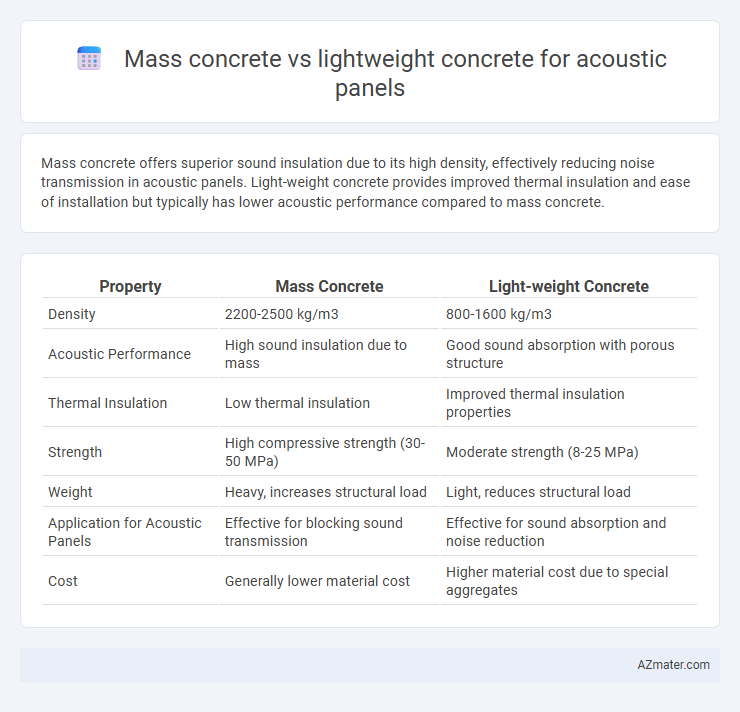Mass concrete offers superior sound insulation due to its high density, effectively reducing noise transmission in acoustic panels. Light-weight concrete provides improved thermal insulation and ease of installation but typically has lower acoustic performance compared to mass concrete.
Table of Comparison
| Property | Mass Concrete | Light-weight Concrete |
|---|---|---|
| Density | 2200-2500 kg/m3 | 800-1600 kg/m3 |
| Acoustic Performance | High sound insulation due to mass | Good sound absorption with porous structure |
| Thermal Insulation | Low thermal insulation | Improved thermal insulation properties |
| Strength | High compressive strength (30-50 MPa) | Moderate strength (8-25 MPa) |
| Weight | Heavy, increases structural load | Light, reduces structural load |
| Application for Acoustic Panels | Effective for blocking sound transmission | Effective for sound absorption and noise reduction |
| Cost | Generally lower material cost | Higher material cost due to special aggregates |
Introduction to Acoustic Panels: Mass Concrete vs Light-Weight Concrete
Acoustic panels made from mass concrete provide superior sound insulation due to their high density and ability to absorb low-frequency noise effectively. Light-weight concrete panels offer enhanced sound absorption with better thermal insulation and easier installation, making them suitable for a range of acoustic treatments. Selecting between mass concrete and light-weight concrete depends on specific acoustic performance goals, structural requirements, and budget considerations.
Composition and Material Properties
Mass concrete for acoustic panels primarily consists of dense aggregates like crushed stone and cement, offering high density and soundproofing through mass absorption and blocking sound transmission. Light-weight concrete incorporates porous materials such as expanded clay, perlite, or foamed aggregates, reducing density while enhancing sound absorption through increased porosity and internal air voids. The material properties of mass concrete emphasize durability and sound insulation, whereas light-weight concrete balances acoustic performance with reduced weight and improved thermal insulation.
Sound Absorption Capabilities
Mass concrete offers superior soundproofing due to its high density and ability to block sound transmission, making it ideal for reducing noise pollution in acoustic panels. Light-weight concrete, characterized by its porous structure and lower density, enhances sound absorption by trapping and dissipating sound waves, improving room acoustics and reducing reverberation. Choosing between mass concrete and light-weight concrete depends on whether the priority is sound isolation or sound absorption in acoustic panel applications.
Density and Acoustic Performance
Mass concrete, characterized by its high density typically ranging from 2200 to 2500 kg/m3, offers superior sound insulation by effectively blocking airborne noise, making it ideal for acoustic panels requiring maximum sound attenuation. Light-weight concrete, with densities between 400 and 1800 kg/m3 due to the inclusion of lightweight aggregates such as expanded clay or pumice, provides better sound absorption and reduced structural load but generally lacks the mass necessary for optimal noise blocking. Acoustic performance depends on balancing density and porosity; mass concrete excels in soundproofing through mass law, while lightweight concrete enhances sound absorption by dissipating sound waves within its porous matrix.
Installation Methods and Structural Requirements
Mass concrete acoustic panels require robust structural support due to their high density and weight, typically installed using heavy-duty anchors and reinforced framing to ensure stability and minimize vibration. Light-weight concrete panels benefit from easier handling and faster installation processes, often utilizing lighter mounting brackets and adhesive bonding methods suitable for less load-bearing structures. Both types demand precise alignment and secure fastening, but light-weight panels reduce structural demands, enabling installation on a wider range of surfaces with less reinforcement.
Durability and Lifespan Comparison
Mass concrete offers superior durability and longer lifespan for acoustic panels due to its high density and resistance to environmental wear, often lasting over 50 years with minimal maintenance. Lightweight concrete, while easier to handle and install, typically has lower compressive strength and susceptibility to moisture damage, which can reduce its durability and lifespan to around 20-30 years. Selecting mass concrete ensures enhanced structural integrity and sustained acoustic performance in high-demand environments.
Cost Implications and Budget Considerations
Mass concrete panels generally incur higher material and transportation costs due to their density and weight, leading to increased structural support expenses. Lightweight concrete offers cost savings through easier handling, reduced labor, and decreased structural load requirements, resulting in overall budget efficiency. However, project-specific acoustic performance needs may influence whether the initial cost difference aligns with long-term value and maintenance considerations.
Environmental Impact and Sustainability
Mass concrete for acoustic panels offers higher durability and thermal mass but involves greater carbon emissions due to heavier cement content and energy-intensive production processes. Lightweight concrete reduces environmental impact through lower material density, enhanced insulation properties, and often incorporates recycled aggregates, contributing to improved sustainability and reduced embodied carbon. Selecting lightweight concrete can lead to energy savings in manufacturing and transportation, aligning with eco-friendly construction practices and green building certifications.
Practical Applications in Construction
Mass concrete offers superior sound insulation and durability for acoustic panels, making it ideal for heavy-duty industrial and commercial construction environments. Light-weight concrete provides enhanced thermal insulation and ease of installation, suitable for residential buildings and renovation projects requiring reduced structural load. Both materials cater to different acoustic performance needs, with mass concrete excelling in noise reduction and light-weight concrete optimizing energy efficiency.
Conclusion: Choosing the Right Concrete for Acoustic Panels
Mass concrete offers superior sound insulation due to its high density, effectively reducing noise transmission in acoustic panels. Light-weight concrete provides advantages in ease of installation and thermal insulation but may require additional treatments to match the acoustic performance of mass concrete. Selecting the right concrete depends on balancing acoustic requirements with structural and thermal considerations for optimal panel performance.

Infographic: Mass concrete vs Light-weight concrete for Acoustic panel
 azmater.com
azmater.com